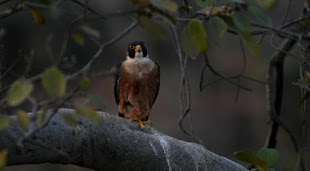
Also read: Of Owl Crisis and Sorcerers
Director of Panna national park Uttam Kumar Sharma confirmed that , “ Peregrine falcons can attain this very high speed while taking its dive”. A good number of Shaheens were sighted in Panna tiger reserve where the number of endangered vultures has increased from 666 last year to 722 in 2021, maximum in any other national park of the state.
Wildlife experts said that Peregrines use a “specific flying technique when hunting and it is known as stoop.” The stoop is gravity-assisted and is considered more a controlled fall . “They fly high above their prey and close their wings falling like a stone downwards . Their aerodynamic shape helps attain high velocity speed stunning their targets .
However, their normal flight was recorded between 22 and 26 mph.Partners in Flight, is an organization launched in 1990 in response to growing concerns about declines in the populations of many land bird species, estimated in 2020 the global breeding population to be 140,000 with 17% spending some part of the year in the U.S, 5% in Canada, and 5% in Mexico. Their population in India is unknown.



Interesting read !!
ReplyDelete